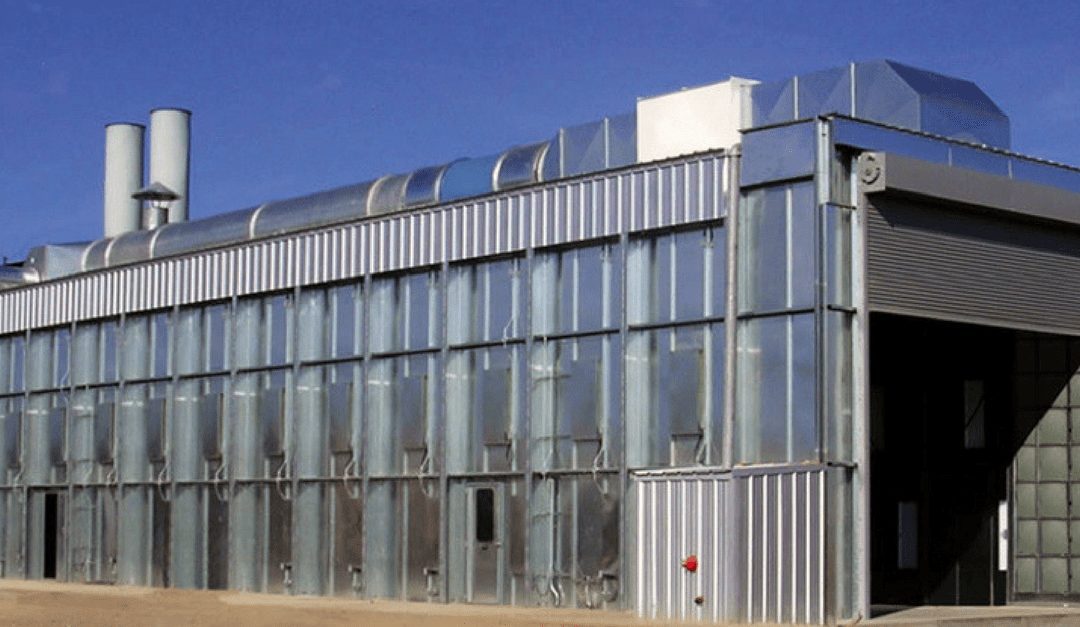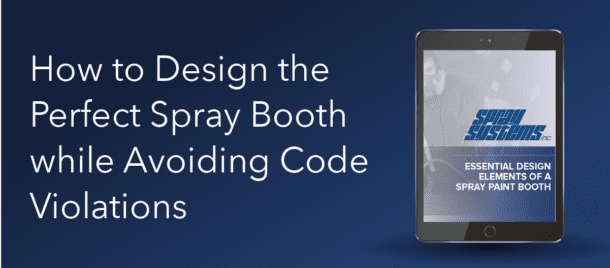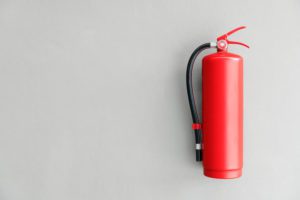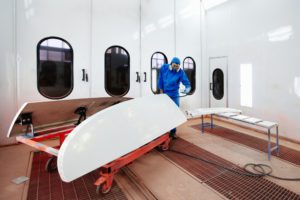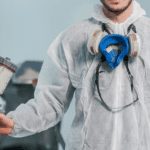Read Time: 4 minutes
Summary:
- The key issue for finishers and spray booth designers to consider is whether a 100 percent exhaust removal is required or can an 80/20 percent recirculating booth be used.
- The principle of recirculating the air is: recirculate 80 percent of the air through the exhaust plenum’s 3-4 stage filter system and reintroduce this particulate-free, clean air back into the booth’s atmosphere as supply air.
- The NFPA requires that any spray application using flammable or combustion materials be limited to a specific VOC concentration that does not exceed 25 percent of the LEL. In recirculating booths, LEL’s maintain a range of five to 10 percent.
- OSHA has in place strong respiratory protection standards, which require that all respirators and other personal protective equipment be approved if an operator will be exposed to paint solvent or VOC concentrations that surpass the OSHA Permissible Exposure Limit (PEL).
- Some cautions when considering purchasing a recirculating booth are: operators who still use PPE can still be “exposed” to higher LEL levels and they must maintain and monitor the three or four-stage filtration system to ensure proper air flow.
- Prospective owners should carefully analyze their needs as well as their budget for installation and long-term use before exploring their equipment options. Recirculation is a major feature that can be added to various types of spray booths, including those designed for crossdraft or downdraft airflow.
The key issue for finishers and spray booth designers to consider is whether a 100 percent exhaust removal is required or can an 80/20 percent recirculating booth be used. By definition, a 100 percent exhaust design does have its inherent inefficiencies when dealing with larger volumes of air as required in booths that must accommodate VOC abatement or temperature/humidity control.
Where this accommodation applies, the principle of recirculating the air is simple: recirculate 80 percent of the air through the exhaust plenum’s 3-4 stage filter system and reintroduce this particulate-free, clean air back into the booth’s atmosphere as supply air. In this case, 20 percent of fresh air is introduced into the booth in addition to the recirculation air and is exhausted at the same rate.
Keeping it Safe and Fresh
The idea of supplying and exhausting 20 percent of the booth’s air volume is based upon keeping the atmosphere inside the booth at a safe level, or 25 percent of the LEL (lower explosive limit).
The National Fire Protection Association (NFPA) requires that any spray application using flammable or combustion materials be limited to a specific VOC concentration that does not exceed 25 percent of the LEL. In recirculating booths, LEL’s maintain a range of five to 10 percent.
By only conditioning, the fresh air at 20 percent, the initial capital equipment costs are greatly reduced as well as ongoing operating costs. Theoretically, the equipment and operating costs are reduced by 80 percent. For example, if equipment needed to treat 40,000 CFM at 100 percent exhaust air, then a recirculating booth design conditioning only 20 percent of this volume equates to only 8,000 CFM.
OSHA has in place strong respiratory protection standards, which require that all respirators and other personal protective equipment (PPE) be approved if an operator will be exposed to paint solvent or VOC concentrations that surpass the OSHA Permissible Exposure Limit (PEL). When paint solvents or chemicals are involved, toluene will be set to 50 ppm and acetone will is set to 500 ppm. It is required that a respiratory protection program is in place if a solvent hazard ratio exceeds 1.0.
Cautions When Considering this Recirculation Solution
- Finisher must have LEL monitoring to ensure that 25 percent of the LEL is maintained inside the booth to protect the operator, property and equipment
- Operators who still use personal protection equipment (PPE) can still be “exposed” to higher LEL levels
- Operators must maintain and monitor the three or four-stage filtration system to ensure proper air flow
- Operators must understand and manage the cost of the “three-stage filter change-out” due to the air constantly circulating through the three-stage filter system
The Bottom Line in Regards to Recirculating Booths
If designed properly, all of the concerns above can be responsibly addressed while benefiting from the greatly reduced equipment and operating costs. There are dozens of factors to consider when selecting a spray paint booth, including chemical composition of airflow and dimensions of the products or parts that will be treated. Prospective owners should carefully analyze their needs as well as their budget for installation and long-term use before exploring their equipment options. Recirculation is a major feature that can be added to various types of spray booths, including those designed for crossdraft or downdraft airflow. While this feature offers several significant advantages for certain applications, there are also potential complications associated with operation and maintenance.
Applications for Recirculation Systems
Automated booths that don’t require workers to actually enter the chamber are best-suited for these systems since most of the concerns regarding the technology revolve around employee safety. While unmanned booths still need to be monitored to maintain a safe environment for people and products alike, there is a limited risk of exposure for operators outside the booth. Spray booths that generate significant operational costs due to abatement of VOCs or other compounds are also prime candidates for recirculation.
As a leading manufacturer of spray paint booths, we encourage all of our customers to take the time to really understand their own needs, concerns and limitations when selecting booth designs. We can also aid you through consultation with industry experts who can offer insight and guidance during the selection process to help avoid costly oversights. Our commitment to reliability, excellence and customer service shines through in all of our operations, particularly in our customized booth solutions that are tailored to perfectly fit specific customer needs. For more information on spray booths, contact us here.
